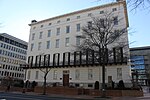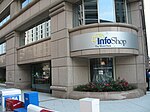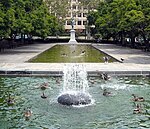Ringgold–Carroll House
Federal architecture in Washington, D.C.Foggy BottomHouses completed in 1825Houses on the National Register of Historic Places in Washington, D.C.Washington, D.C. building and structure stubs

The Ringgold–Carroll House (also formerly known as the John Marshall House and now known as the DACOR-Bacon House ) is a historic residence located at 1801 F St Northwest, Washington, D.C. One of the finest of the few remaining examples of Federal period residential architecture in the neighborhood of the White House, it is listed on the National Register of Historic Places. It has been adapted from a historic home into a private club and office space by DACOR (Diplomatic and Consular Officers, Retired) and the DACOR-Bacon House Foundation.
Excerpt from the Wikipedia article Ringgold–Carroll House (License: CC BY-SA 3.0, Authors, Images).Ringgold–Carroll House
F Street Northwest, Washington
Geographical coordinates (GPS) Address Phone number Website External links Nearby Places Show on map
Geographical coordinates (GPS)
| Latitude | Longitude |
|---|---|
| N 38.8975 ° | E -77.041916666667 ° |
Address
Dacor Bacon House Museum (Ringold-Carroll House)
F Street Northwest 1801
20037 Washington
District of Columbia, United States
Open on Google Maps








